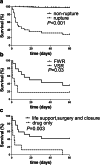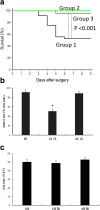Cardiac rupture complicating acute myocardial infarction: the clinical features from an observational study and animal experiment
- PMID: 32912149
- PMCID: PMC7488297
- DOI: 10.1186/s12872-020-01683-y
Cardiac rupture complicating acute myocardial infarction: the clinical features from an observational study and animal experiment
Erratum in
-
Correction to: Cardiac rupture complicating acute myocardial infarction: the clinical features from an observational study and animal experiment.BMC Cardiovasc Disord. 2020 Oct 8;20(1):441. doi: 10.1186/s12872-020-01713-9. BMC Cardiovasc Disord. 2020. PMID: 33032539 Free PMC article.
Abstract
Background: Cardiac rupture (CR) is a fatal complication of ST-elevation myocardial infarction (STEMI) with its incidence markedly declined in the recent decades. However, clinical features of CR patients now and the effect of reperfusion therapy to CR remain unclear. We investigated the clinical features of CR in STEMI patients and the effect of reperfusion therapy to CR in mice.
Methods: Two studies were conducted. In clinical study, data of 1456 STEMI patients admitted to the First Hospital, Xi'an Jiaotong University during 2015.12. ~ 2018.12. were analyzed. In experimental study, 83 male C57BL/6 mice were operated to induce MI. Of them, 39 mice were permanent MI (group-1), and remaining mice received reperfusion after 1 h ischemia (21 mice, group-2) or 4 h ischemia (23 mice, group-3). All operated mice were monitored up to day-10. Animals were inspected three times daily for the incidence of death and autopsy was done for all mice found died to determine the cause of death.
Results: CR was diagnosed in 40 patients: free-wall rupture in 17, ventricular septal rupture in 20, and combined locations in 3 cases. CR presented in 19 patients at admission and diagnosed in another 21 patients during 1 ~ 14 days post-STEMI, giving an in-hospital incidence of 1.4%. The mortality of CR patients was high during hospitalization accounting for 39% of total in-hospital death. By multivariate logistic regression analysis, older age, peak CK-MB and peak hs-CRP were independent predictors of CR post-STEMI. In mice with non-reperfused MI, 17 animals (43.6%) died of CR that occurred during 3-6 days post-MI. In MI mice received early or delayed reperfusion, all mice survived to the end of experiment except one mouse died of acute heart failure.
Conclusion: CR remains as a major cause of in-hospital death in STEMI patients. CR patients are characterized of being elderly, having larger infarct and more server inflammation. Experimentally, reperfusion post-MI prevented CR.
Keywords: Acute myocardial infarction; Cardiac rupture; Prognosis; Reperfusion; Risk factor; Sudden cardiac death.
Conflict of interest statement
The authors declare no competing interests.
Figures






Similar articles
-
Development and validation of clinical risk score to predict the cardiac rupture in patients with STEMI.Am J Emerg Med. 2017 Apr;35(4):589-593. doi: 10.1016/j.ajem.2016.12.033. Epub 2016 Dec 15. Am J Emerg Med. 2017. PMID: 28132793
-
Cardiac rupture in acute myocardial infarction with ST segment elevation. Clinical course and prognosis.Kardiol Pol. 2004 Aug;61(8):127-37; discussion 137. Kardiol Pol. 2004. PMID: 15457279
-
Combination of eosinophil percentage and high-sensitivity C-reactive protein predicts in-hospital major adverse cardiac events in ST-elevation myocardial infarction patients undergoing primary percutaneous coronary intervention.J Clin Lab Anal. 2020 Sep;34(9):e23367. doi: 10.1002/jcla.23367. Epub 2020 May 22. J Clin Lab Anal. 2020. PMID: 32441412 Free PMC article.
-
Do We Need Potent Intravenous Antiplatelet Inhibition at the Time of Reperfusion During ST-Segment Elevation Myocardial Infarction?J Cardiovasc Pharmacol Ther. 2019 May;24(3):215-224. doi: 10.1177/1074248418812167. Epub 2018 Dec 18. J Cardiovasc Pharmacol Ther. 2019. PMID: 30563349 Review.
-
Heart Failure at Admission Complicating ST-Elevation Myocardial Infarction in a Middle-Income Country. Experience of the ARGEN-IAM-ST Registry.Curr Probl Cardiol. 2024 Jan;49(1 Pt B):102076. doi: 10.1016/j.cpcardiol.2023.102076. Epub 2023 Sep 14. Curr Probl Cardiol. 2024. PMID: 37716540 Review.
Cited by
-
Diagnosis of post-myocardial infarction left ventricular rupture on CT.BJR Case Rep. 2022 Apr 25;8(4):20220008. doi: 10.1259/bjrcr.20220008. eCollection 2022 Jul 1. BJR Case Rep. 2022. PMID: 36451900 Free PMC article.
-
Successful emergency surgical intervention in acute non-ST-segment elevation myocardial infarction with rupture: A case report.World J Clin Cases. 2025 Feb 6;13(4):100375. doi: 10.12998/wjcc.v13.i4.100375. World J Clin Cases. 2025. PMID: 39917579 Free PMC article.
-
Risk factors for cardiac rupture after acute ST-segment elevation myocardial infarction during the percutaneous coronary intervention era: a retrospective case-control study.J Thorac Dis. 2022 Apr;14(4):1256-1266. doi: 10.21037/jtd-22-394. J Thorac Dis. 2022. PMID: 35572908 Free PMC article.
-
The Prognostic Value of Creatine Kinase-MB Dynamics after Primary Angioplasty in ST-Elevation Myocardial Infarctions.Diagnostics (Basel). 2023 Oct 6;13(19):3143. doi: 10.3390/diagnostics13193143. Diagnostics (Basel). 2023. PMID: 37835886 Free PMC article.
-
Senescence and senolytics in cardiovascular disease: Promise and potential pitfalls.Mech Ageing Dev. 2021 Sep;198:111540. doi: 10.1016/j.mad.2021.111540. Epub 2021 Jul 6. Mech Ageing Dev. 2021. PMID: 34237321 Free PMC article. Review.
References
-
- Figueras J, Alcalde O, Barrabes JA, Serra V, Alguersuari J, Cortadellas J, Lidon RM. Changes in hospital mortality rates in 425 patients with acute ST-elevation myocardial infarction and cardiac rupture over a 30-year period. Circulation. 2008;118:2783–2789. doi: 10.1161/CIRCULATIONAHA.108.776690. - DOI - PubMed
-
- Pohjola-Sintonen S, Muller JE, Stone PH, Willich SN, Antman EM, Davis VG, Parker CB, Braunwald E. Ventricular septal and free wall rupture complicating acute myocardial infarction: experience in the multicenter investigation of limitation of infarct size. Am Heart J. 1989;117:809–818. doi: 10.1016/0002-8703(89)90617-0. - DOI - PubMed
-
- Honda S, Asaumi Y, Yamane T, Nagai T, Miyagi T, Noguchi T, Anzai T, Goto Y, Ishihara M, Nishimura K, Ogawa H, Ishibashi-Ueda H, Yasuda S. Trends in the clinical and pathological characteristics of cardiac rupture in patients with acute myocardial infarction over 35 years. J Am Heart Assoc. 2014;3:e000984. doi: 10.1161/JAHA.114.000984. - DOI - PMC - PubMed
-
- Becker RC, Hochman JS, Cannon CP, Spencer FA, Ball SP, Rizzo MJ, Antman EM. Fatal cardiac rupture among patients treated with thrombolytic agents and adjunctive thrombin antagonists: observations from the thrombolysis and thrombin inhibition in myocardial infarction 9 study. J Am Coll Cardiol. 1999;33:479–487. doi: 10.1016/S0735-1097(98)00582-8. - DOI - PubMed
-
- French JK, Hellkamp AS, Armstrong PW, Cohen E, Kleiman NS, O'Connor CM, Holmes DR, Hochman JS, Granger CB, Mahaffey KW. Mechanical complications after percutaneous coronary intervention in ST-elevation myocardial infarction (from APEX-AMI) Am J Cardiol. 2010;105:59–63. doi: 10.1016/j.amjcard.2009.08.653. - DOI - PubMed
Publication types
MeSH terms
Grants and funding
LinkOut - more resources
Full Text Sources
Research Materials
Miscellaneous

